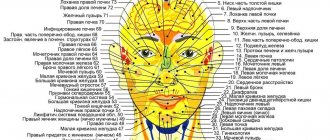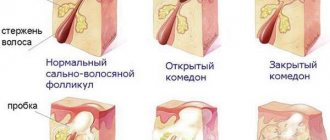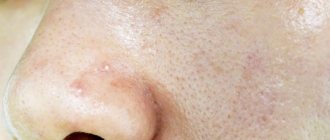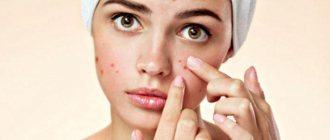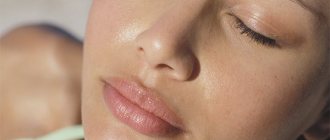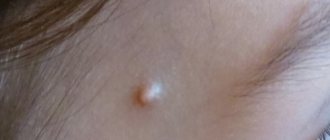Pimples under the nose are a common occurrence for many people. This problem causes a lot of trouble, the appearance of the face suffers, the mood deteriorates, and acne is an inflammatory process that can cause quite serious harm to health. So, why unpleasant rashes occur, and how to get rid of acne under the nose, we will talk later in the article.
Causes of rashes around the mouth in children
A rash around the mouth in a child of different ages occurs for several reasons:
- excessive salivation;
- violation of hygiene;
- infectious diseases;
- dermatitis;
- helminthic infestation;
- influence of external factors.
A rash around a child's mouth can be caused by many factors that are important to identify for proper treatment.
Many of these reasons are associated with vitamin deficiency and the use of hormonal drugs to treat certain diseases. The impetus for the spread of the rash can be a disruption of the digestive tract. This is both an imperfection of the enzymatic system and functional disorders.
Children of different ages go through several growth spurts. These are the stages of maturation of internal and endocrine organs. Therefore, a rash may appear for some period of time and go away on its own.
What ointments for a runny nose can be used for children?
Many parents believe that ointments can help in treating a runny nose, since they have a thick consistency and do not get into the throat, which often causes discomfort in a small child.
However, you should listen to the opinion of experts who claim that not all of them can be recommended for children.
Safe for children over 2 years old are Golden Star (Asterisk) balm, Evamenol, Fleming and Thuja ointments. They are based on petroleum jelly and herbal extracts.
After consultation with the doctor, it is possible to use oxolinic and ichthyol ointments, Viferon. It should be noted that the listed drugs will be truly effective only as part of complex therapy.
Attention
The use of ointments based on Vaseline and herbs for the treatment of infants is undesirable. Uncontrolled use without prior consultation with a doctor can lead to disruption of the mucous membranes of the nasal cavity.
There is no ointment designed specifically for infants. In the treatment of ARVI for children, Vishnevsky, Levomekol and tetracycline ointments are not used.
Environmental factors
Rash and irritation around a child's mouth often occurs if the skin is exposed to:
- wind;
- ultraviolet radiation;
- humid hot climate.
A baby's skin is very delicate, so it needs to be protected from open sunlight. The result of insolation is the appearance of red spots and rashes. If a child has increased salivation and is outdoors, then when there are gusts of wind, the skin may become chapped, reddened, and covered with dermatological elements.
The increase in symptoms occurs gradually: from the first hours, dry skin appears, then it turns red, and blisters with watery contents appear. When the climate changes or vacations in hot countries, the elements appear due to the onset of excessive work of the sebaceous glands.
Neonatal acne in newborns
Newborns include children up to 28 days of life. Some mothers notice irritation on the baby's skin during this period, which makes them worry. This condition is typical for 20-30% of children and refers to physiological phenomena.
A rash around a child’s mouth is a consequence of hormonal changes in the body, which begins to live independently.
The second reason for the phenomenon is the proliferation of yeast-like fungi on the surface of the body, which need sebum for nutrition. Externally, it is not difficult to determine that this is acne of the perinatal period. The elements are pointed, with a white shaft in the center. The contents of the vesicle are viscous, which distinguishes clear discharge from herpes infection or dermatitis.
Unlike other causes of its appearance, newborn acne migrates over the face and neck and is not typical for other parts of the body, as with urticaria and miliaria. In addition, there are no signs of intoxication, which would indicate an infectious process.
Summarizing
The recommendations given in this article are confirmed by the experience of doctors and patients themselves. Among them there are rules that are common to successfully combat all types of rashes:
- Hygiene.
- Drinking regime.
- Proper nutrition.
- Refusal of self-medication.
You just have to want it and you can say goodbye to acne forever. It is important to have diligence and patience here. This is the only way to achieve a long-term effect from treatment.
And although the most common reason for the appearance of pimples and comedones around the nose is a banal lack of care, they can signal you about serious problems with the body!
After reading the article to the end, you will receive clear and effective methods for getting rid of this problem and, possibly, prevent further complications. I promise that the article will be without boredom and water - just to the point.
Irritation from drooling in infants
Starting at approximately 4 months, the baby begins a period of hypersalivation. Parents notice that the child has a lot of saliva, which hangs like ropes from his mouth. This is due to the start of the salivary glands, although it often coincides with the period of teething.
Physiologists believe that this is a protective mechanism that allows you to get rid of microorganisms that get into your mouth with your hands. Due to the constant damp environment, redness and irritation appear on the chin. Mechanical removal of viscous secretion does not produce results.
Hypersalivation can be caused by pathological conditions:
- oral candidiasis;
- helminthic infestation;
- otitis;
- diseases of the central nervous system;
- intoxication as a result of exposure to heavy metal salts.
If a large amount of saliva appears, pathology must be excluded. You need to blot the skin with a disposable or reusable clean scarf.
Atopic dermatitis or infantile eczema
Atopic dermatitis is a reaction to hazardous foods. Redness can occur on the body in the chest area, arms and neck. If the allergen is not excluded, the elements open up, begin to get wet, and the skin becomes very itchy.
Five foods that cause atopic dermatitis
Genes responsible for predisposition to the development of the disease have been identified. But it can be realized only with an initially low state of immunity. Often, manifestations of pathology begin under the influence of a stress factor. If there are inflammatory skin diseases, traumatic injuries, then this is the entrance gate for infection and allergens.
The cause of the development of dermatitis can be food, respiratory antigens, or the body’s reaction to long-term use of antibiotics.
Tips for proper treatment of atopic dermatitis:
Acne in the temporal area
The temple area has relatively thin skin, on which rashes rarely appear. But if they are, then pay attention to the following possible reasons:
- Gallbladder diseases. Cholecystitis and biliary dyskinesia are often the cause of acne in the temple area.
- Lymph flow disturbances. If for some reason the lymphatic system ceases to cope with its function, various harmful substances accumulate in the lymph, which lead to skin rashes.
- Vitamin deficiencies . Lack of vitamins A, C, E, B manifests itself throughout the skin of the body, including the temples.
- Hormone surges. Most often, hormonal acne affects teenagers and women.
Some recommendations that will help you forget about acne on your temples forever:
- check your gallbladder, cure existing problems;
- undergo diagnostics of the lymphatic system;
- make your diet more varied, consisting mainly of vitamin-rich foods;
- adjust hormonal levels.
These recommendations can only be implemented with the help of a competent doctor. An endocrinologist, gastroenterologist, and lymphologist will help.
Allergy
Inflammation of the skin around the mouth often appears as a result of allergies. You can suspect this cause if the child has moved from infancy to the junior preschool group, teeth have already erupted, and the rashes are periodic. This means that the body reacts to certain foods , the rest of the time the immune system functions quietly.
Allergens are divided into several categories, depending on the route of entry. Often with this form of the disorder other symptoms appear: lacrimation, runny nose, swelling of the mucous membranes. The use of anti-cold medications has no effect.
What is a cold runny nose
A cold or rhinitis is a disease of the upper respiratory tract, in particular the nasal mucosa.
The organ cavity constantly produces fluid that maintains optimal humidity and prevents infection. In addition, the liquid filters and warms the inhaled air. It is then carried by the cilia of the cavity, which deliver this mucus inside. When the membrane is irritated, it swells, accelerating the secretion of fluid to remove viruses. In addition, the space available for mucus is reduced. The result is a runny nose. There is an unpleasant feeling of congestion.
Perioral dermatitis
Perioral dermatitis occurs mainly in young people, under 20 years of age. People who use hormonal-based cosmetics are at risk. In children, the disorder appears in no more than 5% of all cases, followed by peeling and the appearance of small dotted elements with a white dot in the center. Localization of manifestations is the chin, nasolabial triangle.
As the elements spread, they merge with each other and infection occurs. The rash does not cause significant discomfort or itching. If treatment is not started at an early stage, the skin becomes rough and may change color to brown. Subsequently, the restoration of the normal pale pink color of the cover does not occur.
This type of irritation occurs for several reasons:
- decreased immunity;
- the use of hormonal agents to combat dermatitis;
- allergy;
- hormonal changes;
- skin damage from bacteria;
- vitamin deficiency;
- diseases of the gastrointestinal tract;
- use of fluoride-containing paste;
- disruption of the nervous system;
- prolonged exposure to the sun.
The border between diseased and healthy skin is defined as a thin white film.
Herpes
Decreased immunity can be caused by viral and bacterial infections. Often a sign of unstable functioning of the protective system is a herpetic rash. These are small elements with watery contents. The appearance of herpetic elements in an infant is a very unfavorable sign.
As a rule, infection occurs through direct contact with close relatives during an exacerbation period.
Since immunity is just being formed, innate immunity and protective factors contained in breast milk protect for up to 6 months, herpetic eruptions may indicate congenital pathologies with an immunosuppressive effect.
An exacerbation of the infection is typical after the age of 3 years , when the child begins to visit kindergartens, come into contact with various bacteria and viruses, and enters the social sphere.
Other causes of rash around a child's mouth
If there are no signs of allergies, dermatitis or enterovirus infection, then the appearance of irritation may be associated with individual characteristics of digestion. In this case, the child has unstable stools, a tendency to constipation, and particles of undigested food in the stool. This may occur due to inappropriate nutrition for the child's age.
The most common cause of the disorder is infection. The aggressive factor is staphylococcus, an element of normal microflora. With hypothermia and decreased immunity, it begins to multiply on the skin, causing a pustular rash on the face and other parts of the body.
Fungal flora also reacts to decreased immunity. If the mother had thrush during pregnancy, which was not completely cured at the time of birth, then candida remains on the surface of the body and can appear at any time. A sign of a fungal infection is the presence of white or yellowish patches that peel off when rubbed.
If there is a strong wind outside and the face is not protected, then foci of peeling appear on the chin and in the perioral area. This is caused by chapping of the surface of the skin.
Violation of personal hygiene rules is an additional factor in changes in the condition of the protective cover. If you touch your mouth with unwashed hands, bacteria begin to multiply on the mucous membrane.
Other reasons may be:
- allergy to the latex from which the pacifier is made;
- consequence of vaccination;
- insect bite
The main sign indicating the category of rash is the nature of the rash and the presence of auxiliary symptoms.
Why do acne occur?
Any kind of acne always has one common cause - blockage of the sebaceous ducts. Behind this process there is a factor that provokes it. It could be:
- problems with hormones;
- poor metabolism;
- poor nutrition;
- comedogenic cosmetics;
- allergy;
- intoxication of the body;
- helminthiasis;
- demodicosis;
- environmental influence;
- heredity;
- stress component;
- immunodeficiency;
- vitamin deficiency;
- diseases of internal organs.
You can learn more about the last factor if you pay attention to the location of the rash (see photo).
Acne on the face by zone
What does the color and type of rash indicate?
All types of rash are different. Therefore, the external manifestations of the elements can tell the doctor a lot. A pinpoint rash often indicates an infectious process and intoxication. If it is filled with fluid, it is caused by the herpes virus.
When the rash is detected only in one place, the cause is most often local in nature . If elements appear on the back, arms, neck, then the matter is in internal processes.
Based on the appearance of the manifestations, one can suspect the cause of the phenomenon:
| Disease | Appearance of the rash |
| Perinatal acne | Small elements with a white rod inside. Contents viscous |
| Atopic dermatitis | The elements merge with each other, the surface of the skin is red and peeling |
| Herpes | Bubbles of different sizes, filled with clear liquid |
| Allergy | Elements rise above the surface of the skin, the skin around is red, there is no content inside |
| Weathering | Characterized by redness of the skin, areas of peeling and itching |
| Worm infestation | The rash is pinpoint, elements without content, appear in the area of the nasolabial triangle, neck |
| Perioral dermatitis | At first, the elements are located separately, then merge with each other, pus appears, wet areas appear, the surface peels off |
Symptoms
Regardless of who suffered from the rash, the doctor’s tactics at the initial stage are the same: first find out complaints and medical history, and then conduct a physical examination. It is necessary to analyze the information received and determine the nature of skin manifestations:
- Appearance (spots, nodules, blisters).
- Localization (near the nose, on the cheeks, chin, scalp, in the area of natural folds of the skin or on other parts of the body).
- Abundance (single elements or extensive drainage foci).
- Periodicity (appears occasionally or persists almost constantly).
- Connection with certain factors (eating foods, taking medications, using cosmetics, etc.).
Every “little thing” can be useful, so the doctor pays attention to all manifestations, detailing each complaint and continuing the diagnostic search in various directions. Along with facial rashes, children may also have other symptoms:
- Crusts on the scalp (gneiss).
- Sneezing, sore throat, watery eyes, itching.
- Bloating, rumbling, unsteady stool.
- Fever and intoxication.
Having understood the symptoms, the doctor can make a preliminary diagnosis. But it also requires further confirmation.
Diagnostic methods
A rash around a child’s mouth is classified as belonging to a specific type using the same type of research according to the algorithm:
- general blood analysis;
- immunological study for antibodies to the suspected infection;
- general urine analysis;
- prick allergy test;
- stool analysis for worm eggs.
Since a number of conditions are caused by contact with an allergen, conducting a test reduces the time to search for the type of pathogen. An important type of diagnosis is to examine the nature and color of the rash. He tells you what microorganisms it is caused by.
Treatment with drugs depends on the cause of the rash
A rash around a child’s mouth is treated taking into account the cause that caused it. There is no universal remedy that would help in all cases.
Some measures help prevent the development of the disorder:
- compliance with hygiene rules;
- early contact with a doctor;
- for dry skin, you need to use nourishing creams;
- before going outside during the cold period, you need to apply a protective cream;
- use only children's clothing and body care products;
- reduce the time a child spends outdoors in the open sun in summer.
Therapy for the disorder must be comprehensive. These are local and systemic remedies. At all stages of treatment, it is necessary to monitor whether the patient’s condition improves. Once the type of pathogen is determined, etiological treatment is prescribed. It involves antibacterial or antiviral treatment that is active against this pathogen.
In most cases, physiotherapy methods are included in therapy. They help improve local blood flow and have an anti-inflammatory effect. The possibility of using alternative medicine should be checked with a doctor.
Folk remedies for treating rashes around a child’s mouth
Traditional medicine has proven itself to be a simple, inexpensive and safe way to cope with various types of problems. It is not always acceptable for young children, due to the high likelihood of allergies to herbs. When a rash appears around the mouth, products with anti-inflammatory and antiseptic effects help.
For example, the following can cope with perioral dermatitis:
- a decoction of string, St. John's wort, chamomile or sage in the form of lotions on the affected areas every 4-5 hours.
- lubricating the elements with propolis boiled in a water bath;
- using a mixture of honey, flax and onion juice, taken in equal volumes, boiled for 10 minutes. and cooled to room temperature;
- using lotions with soda solution (1 tsp per 1 cup of warm water);
- lotions with pulp or juice of fresh pumpkin;
- application of oak bark decoction topically.
Before using any product for the first time, you need to do a sensitivity test. To do this, apply a decoction to an inconspicuous area of skin and wait for 2 hours for the appearance of inflammation.
The following remedies can also help with atopic dermatitis:
- A mixture of rice starch, glycerin and milk, taken in equal proportions and mixed until smooth. Use as an ointment at night and store in the refrigerator.
- Raw, finely grated potatoes, used as a lotion.
- Mix 2 parts of crushed Kalanchoe leaves with 1 honey and stir. The paste is applied 2-3 times a day to the affected areas of the body. This method is effective, but is used with caution due to the high allergenic properties of honey.
- Celery root juice with salt and a few drops of vinegar is applied as a lotion to the skin 3-4 times a day. After 3 years, it is allowed to take 20 ml orally 2 times daily.
- Cucumber juice is applied every 2-3 hours, which helps moisturize the area and relieve inflammation.
- If 1 tsp.
Boil chamomile in a water bath with the addition of 100 g of vegetable oil, then the resulting composition can be applied to the rash areas up to 3 times a day. Tar, celandine, mash, potatoes are folk remedies that are used in the fight against atopic dermatitis
If your child has chapped lips and the skin around them, you can try to relieve the pain by using vitamin masks. They are used for shallow damage to the epidermis.
The available means are:
- chamomile ointment prepared at home;
- a mixture of liquid honey, vitamin A and E;
- mask made from sour cream or cream with a high degree of fat;
- Vaseline oil mixed with sea buckthorn and apricot oil.
A rash around the mouth, in the area of the nasolabial triangle in a child often occurs as a result of a combination of several factors. Monitoring the child helps to quickly determine the cause of the disorder, which helps avoid unpleasant consequences and complications.
Author: V.L. Dyleiko
Design: Anna Fleyman
Irritation on the nose and around the nose. How to remove it? See inside
Answers:
Tanyushka Zhuravel
Try a baby cream that relieves irritation and redness; in general, baby cream is designed for babies, but in your case it will relieve inflammation and soften it a little, because you can’t further irritate this area of skin. And lubricate it a couple of times, one time won’t help much. Try not to rub with a handkerchief anymore, the area is already irritated.
Marina
Bepenten cream heals very well and quickly, and most importantly relieves pain and itching. (or panthenol)
just me
the simplest thing is any vegetable oil or baby cream (it will sting a little at first)
Floria
Now I have the same thing, saving myself with regular face cream!
Gorgeous
Of course, baby cream or products such as BORO+. If you apply baby cream, it will help, but it will sting terribly.
Friday
I usually save myself with panthenol cream, now I use Boro+, and when I’m at home I smear myself with regular vegetable oil or peach oil.
